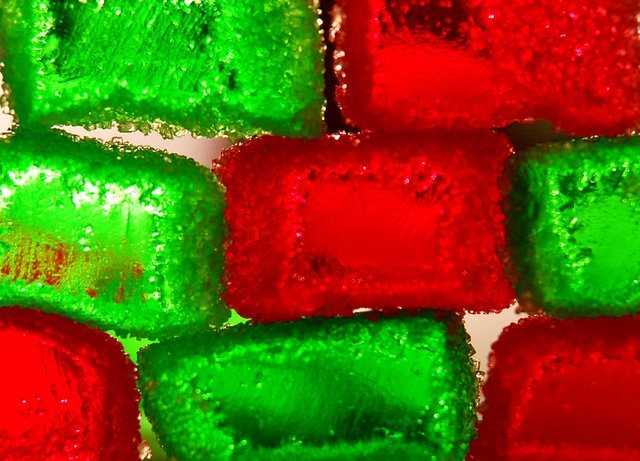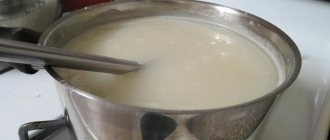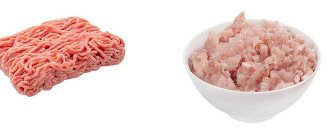Types and categories of marmalade
There are several varieties of marmalade, each of which is particularly popular in different parts of the world. There are mainly 3 types of marmalade: fruit and berry, jelly and fruit and jelly. In addition, each type of marmalade is divided into 2 main categories: natural and industrial with various additives.
Natural marmalade is much healthier than industrial marmalade; it is made from fruit or berry juices and purees, with the addition of a small amount of sugar or its substitutes. In England, marmalade is made mainly from oranges, and in Spain - from quinces. In Russia, the most common marmalade is apple. If you really want, you can make marmalade at home using your favorite fruits and berries.
Calorie content of marmalade: how many calories are in marmalade?
You are here: Home > Articles > Cooking > Calorie content of foods
April 7, 2020 | views: 15,668
Agree, it’s always nice to drink a cup of coffee or a glass of tea with some sweetness. As wits joke, “moments like these are two minutes of joy that turn into two centimeters on the waist.” But it’s simply impossible to live without sweets! Are there really no sweets that would not have such a detrimental effect on our health and waistline? There is marmalade. And although this delicacy has a high calorie content, it does not cause significant harm to the figure.

Calorie content of marmalade
The calorie content of marmalade is about 300 Kcal per 100 g of product, plus/minus 100 Kcal depending on the type and ingredients used. For example, the calorie content of marmalade in sugar or chocolate can reach 410 Kcal per 100 grams. Calorie content 1 pc. marmalade can contain from 25 to 40 kcal, so those who value their figure can eat only 2-3 pieces. per day, but this is quite enough to satisfy the need for sweets.
There are practically no proteins and fats in marmalade, due to which such a low calorie content for sweetness is achieved, while it contains pectin, which rids the body of toxins, normalizes digestion, and reduces cholesterol levels.

How many calories does different types of marmalade contain?
They produce three types of marmalade: fruit and berry jelly, jelly based on thickeners, and “mixed”. Of course, it is rare to find pure fruit and berry marmalade in a supermarket - tasty, healthy, containing a minimum of calories - from 200 Kcal. Jelly marmalade is, of course, filled with various flavors and dyes, which significantly reduce its beneficial characteristics, and its calorie content is slightly higher than that of its natural fruit and berry counterpart. But, despite this, it can be useful for a healthy person: gelatin strengthens hair and significantly improves the condition of the skin.
What ensures the low calorie content of marmalade?
Translucent fruit and berry marmalade that melts in your mouth is made from applesauce with added sugar. For a variety of taste, it includes purees from other berries and fruits. To ensure a jelly-like consistency, pectin, agar or gelatin is added to it. If only a fruit base is used, then the calorie content of marmalade per 100 grams will be from 200 to 250 Kcal. Unfortunately, it is almost impossible to find completely natural sweets on the shelves of our stores and supermarkets, so such a product is very rare.
Most often they produce marmalade with a “mixed” composition: gelatin, various additives, pectin. There are about 300 calories in this marmalade. Therefore, it is important to familiarize yourself with the composition of the product before purchasing. For example, the composition of lemon drops, well known to everyone from childhood, includes sugar, starch molasses, agar, citric acid, egg white, paprika, curcumin, beta-carotene. Calorie content of marmalade “Lemon slices” is 314 Kcal. However, if you care about your health or are buying sweets for your child, then it is better, of course, to opt for regular fruit and berry marmalade without any additives. Indeed, often the packaging does not specifically indicate what flavoring is used in the product, but simply says: identical to natural. This can be vanillin, ethyl formiazit, ethyl acetate and others, the systematic use of which in food causes disruptions in the functioning of the liver, and their use in baby food is generally prohibited.
How many calories are in chewing marmalade?
Chewing marmalade is most often produced in the form of various worms, bears, and the like. The calorie content of chewing marmalade is 300 Kcal per 100 g. The product contains various preservatives, dyes and flavors, which are not always beneficial to our health. But it also contains agar-agar, which has a positive effect on digestion, removes toxins, and enriches the body with minerals and vitamins.
How many calories are in homemade marmalade?
You can prepare low-calorie marmalade based on fruit puree even at home, without using sugar or molasses. Various fruits are suitable for this. In general, back in Portugal, marmalade was made from applesauce - it was boiled down so much that it could be cut with a knife. You can make marmalade in the same way now.
First, the fruits are washed, sorted, seeds are removed, and the stalks are removed. After this, they are boiled until softened, and then rubbed through a sieve or whipped with a blender. Now you can add sugar to the resulting mass. If you want to get low-calorie marmalade, then you can do without it. The recipe may vary depending on your needs and capabilities. Then we continue to boil the mass, stirring from time to time. When a spoon leaves a mark in the mass, it can be poured into molds and cooled.
The calorie content of sugar-free marmalade will be no more than 100 Kcal per 100 grams. The more sugar is added to the mass, the higher the calorie content. Before serving, this marmalade can be sprinkled with sugar or coconut flakes, but do not forget that this also increases its nutritional value. Thus, the calorie content of marmalade with sugar is 10-15% higher than without it.
In general, marmalade, despite even 250-300 Kcal, is relatively low in calories, unlike other sweets. Therefore, if you are worried about your figure, but it is very difficult to do without sweets, eat a few gummies, they are unlikely to cause serious damage to your waistline.
1 comment on this post
- Felix
Nov 12, 2020 at 21:34350 kcal per 100 g is almost like pure sugar! How much water is there? Serious sources provide from 40 to 100 kcal.
Leave your comment: Cancel
Marmalade: composition and beneficial properties
Marmalade contains a large amount of healthy vitamins, minerals and amino acids. It contains vitamins C, E, K, B vitamins, copper, magnesium, calcium, iron, beeswax and vegetable fats. All marmalades contain agar-agar or gelatin, pectin, purees and juices. Agar-agar is obtained from algae, it improves the functioning of the liver and thyroid gland, and removes toxins from the body. Marmalade, thanks to its beneficial properties, improves the functioning of the gastrointestinal tract, lowers cholesterol, and normalizes carbohydrate and lipid metabolism.
Another useful property of marmalade is its ability to heal wounds and burns. Thanks to gelatin, the condition of nails, hair, skin improves, and the skeletal system is strengthened. Many doctors advise using marmalade after long-term illnesses, as it has the ability to restore strength. The sweetness is recommended for people suffering from diabetes, obesity and constipation.
Homemade marmalade: calorie content and recipes
If your goal is not only to eat delicious food, but also to eat healthy and nutritious food, then this chapter is definitely for you. Having considered all the delights of marmalade, we can conclude: what is cheap is harmful, and what is healthy is expensive. And, again, there are no guarantees (what if it’s a fake?).
An alternative, as always, is homemade safe and healthy desserts. Armed with knowledge and the necessary products, we begin to create our own “branded” marmalade with a calorie content of no more than 100 kcal/100 g.
Low-calorie apple marmalade:
- 3 apples;
- A tablespoon of gelatin or pectin;
- Cinnamon on the tip of a knife.
Peel the apples, cut into slices and place in the microwave for 7-10 minutes (maximum power). Beat the prepared apples into puree, add cinnamon and dry gelatin. Stir until the gelatin is completely dissolved. Pour the hot mixture into molds and cool. Place in the refrigerator. The calorie content of marmalade according to this recipe is 60 kcal/100 g.
Pineapple marmalade:
- 300 g pineapple pulp;
- A packet of gelatin (20 g).
Cut the pineapple into cubes, place in a deep plate and pour in a little water. Place in the microwave for 10 minutes. Beat the resulting mass in a blender and add diluted gelatin (a third of a glass of water per gelatin packet). Pour into molds and cool. Calorie content of pineapple marmalade – 65 kcal/100 g.
Homemade marmalade has a number of advantages: it is completely natural, which means it is healthy and safe, does not contain sugar and can be made from your favorite products. In addition, the low calorie content of marmalade made at home allows you to enjoy it without risking your figure.
Popular articles Read more articles
02.12.2013
We all walk a lot during the day. Even if we have a sedentary lifestyle, we still walk - after all, we...
610366 65 More details
Among the leaders of the most harmless sweets is marmalade.
This sweetness originated in Central Asia and the Middle East. Originally it was made from quince. The ancestor of marmalade is called Turkish delight. In ancient times, the delicacy was made by boiling fruit for a long time without additional ingredients. A special consistency was achieved due to the high pectin content. Today, manufacturers are experimenting with various fruits, additives and thickeners. Thanks to this, everyone can choose marmalade to suit their taste.
Types of marmalade
Today, according to the method of preparation, there are four types of marmalade:
- natural from fruit;
- jelly based on pectin, agar-agar or gelatin;
- jelly-fruit marmalade, combining the first two types;
- appeared today - chewable.
Useful properties of marmalade
Each of these types of dessert is healthy in its own way, provided that it contains only natural products and no artificial syrups, dyes or other additives. If the composition contains only fruits, a gelling agent and sugar, then marmalade can be safely consumed.
Dessert
based on pectin
:
- improves digestion,
- normalizes intestinal microflora,
- lowers cholesterol levels,
- removes toxins,
- useful for atherosclerosis/
- reduces sugar levels,
- normalizes carbohydrate and fat metabolism.
marmalade
:
- is a natural source of iodine, therefore it has a positive effect on the thyroid gland;
- facilitates liver function;
- improves gastrointestinal motility;
- like pectin, it is a natural absorbent and removes toxins.
Product
with gelatin:
- improves the condition of skin, nails, hair.
- Strengthens bones
- Restores strength
Chewing marmalade is considered one of the healthiest treats.
.
Its dense structure is formed by combining pectin and agar-agar. Accordingly, it contains twice as many nutrients as other sweet brethren. However, before purchasing, you should carefully study the packaging of such marmalade. After all, it is to it that manufacturers often add a huge amount of dyes, preservatives,
taste improvers and other ingredients that are only “identical” to natural ones.
Calorie content of marmalade
Another undoubted advantage of marmalade is its low calorie content compared to other desserts. One cube usually weighs about 15 grams
. It is especially worth paying attention to marmalade that is not sprinkled with sugar on top.
When purchasing a treat, you must carefully study the composition indicated on the package. Dessert may turn out to be less healthy and higher in calories if manufacturers do not skimp on sugar.
For many, marmalade is one of their favorite treats from childhood. Sticky, thick, it often stuck to the teeth and melted in the mouth with sweet drops... It often remains on the list of taste favorites for more than one decade.
But older boys and girls are more interested not in taste (although that is also important), but in the calorie content of marmalade, not in color, but in the naturalness of the composition and health benefits.
The classic set of ingredients for a classic, again, sweet is another confirmation of the rule: “everything ingenious is simple.” To get the perfect marmalade, you need the following ingredients: fruit puree and/or juice, agar-agar (it can be replaced with gelatin), a little sugar.
Most often, apple, apricot or quince pulp is used to prepare this dessert, which is boiled with sugar and agar-agar. The resulting jelly-like mass is poured into molds and allowed to cool and harden - the delicacy is ready for all times.
You can find many useful substances in such sweetness.
Eg:
- pectin, which is found in fruits and perfectly cleanses the gastrointestinal tract, helping it work better;
- iron, potassium, magnesium, calcium - a whole complex of the minerals we need most, which support the coordinated functioning of internal organs, strengthen the cardiovascular system, bone tissue, improve the composition and circulation of blood;
- Glucose is an excellent source of energy, which also helps maintain brain activity;
- The gelling agents contained in agar-agar (an extract from seaweed) and gelatin (extracted from animal tendons and bones) are extremely beneficial for joints and bone cartilage.
How to choose marmalade?

If you decide to treat yourself and your family to marmalade, it is important to know how to choose it. First, pay attention to the color - it should be dull and close to natural shades (this guarantees the use of only natural ingredients, without the use of dyes).
Never buy marmalade of bright and unnatural colors, or with a strong odor. The composition should not contain sweeteners, preservatives, dyes or substances “identical to natural”. Natural and high-quality marmalade has a sour taste and a glassy structure. When purchasing, squeeze the marmalade - it should not stick to the packaging or change its shape.
Marmalades with fillings
The indicator of how many calories are in marmalade with fillings is somewhat different from previous data. Calorie content, of course, depends on their type. It can be:
- nuts;
- cream;
- pieces of fruit and candied fruits.
Puff marmalade is also produced, in chocolate glaze and coconut flakes. From 335 to 342 kcal - this is how many calories are in marmalade with pieces of fruit . And if candied fruits are used as a filling, the calorie content will increase to 350 kcal per hundred grams.
Marmalade with nuts is even higher in calories (the figure can reach 398 kcal per hundred grams).
But if you make marmalade at home - from apples, pectin and cinnamon, or based on pineapple pulp, then it will be the lowest calorie marmalade. No more than 100 kcal per hundred grams - that’s how many calories there are in homemade marmalade .
Preparation:
- You can use store-bought juice or freshly squeezed juice. Pour the juice into a large saucepan, heat it and add the gelatin. Cook the mixture for 7 minutes.
- In a separate saucepan, combine sugar and water, place on heat and bring to a boil.
- Cook the syrup over low heat until the sugar is completely dissolved.
- Pour the boiling syrup into the gelatin mixture, mix everything well until the gelatin is completely dissolved.
- Strain the finished mixture and pour into molds. Leave the mixture to cool.
- When the marmalade has hardened, remove it from the mold and roll it in sugar.
The benefits of marmalade
The benefits of marmalade are due to the herbal ingredients it contains. These are gelling substances such as agar-agar, pectin, applesauce, gelatin, fruit juices. Each of these ingredients has a beneficial effect on the body, and at the same time they do not greatly increase the calorie content of marmalade. For example, pectin perfectly cleanses the body of waste and toxins. It helps get rid of bile acids, metabolic products and other harmful substances that disrupt the normal functioning of the body. Among other things, pectin also removes heavy metals and radioactive substances, which can lead to cancer. Pectin is useful for diseases of the liver, gastrointestinal tract, as well as disorders of carbohydrate and lipid metabolism. Thus, those who are worried about how many calories are in marmalade should first appreciate its wonderful cleansing qualities.
Agar-agar is a substance no less useful for the human body. This substance is made from seaweed. Agar-agar is a rich source of iodine and is especially recommended for people with thyroid diseases. Also, agar-agar helps to normalize intestinal function, as it swells well and promotes better peristalsis. And since the calorie content of marmalade is low, it can be consumed as often as the need arises.
Gelatin, which is part of marmalade, helps improve the condition of skin and hair. There is no need to talk about the benefits of fruit juices. They are a rich source of vitamins and minerals, which makes marmalade not just a delicious dessert, but also a wonderful healthy product. Thus, regular consumption of marmalade can solve certain health problems. But this is only true when the marmalade is prepared from natural ingredients according to a traditional recipe.
The question of how many calories are in marmalade is quite natural, because this sweet delicacy is classified as a dessert, and most of them are not at all welcome in dietetics. But don’t be afraid of the calorie content of marmalade; it is much lower than the calorie content of traditional desserts.
The calorie content of marmalade is 293 kcal. For comparison, the calorie content of chocolates is 570 kcal. As you can see, the calorie content of marmalade is almost half as much, and by eating just one candy you can fully enjoy the sweet taste, which is what is actually expected from desserts.
It is necessary to distinguish traditional marmalade from chewing marmalade. The latter is distinguished by the fact that it additionally contains carnauba wax or another wax-fat mixture, which provides a denser consistency of the marmalade, and also that the candies do not stick together. At the same time, the calorie content of chewing marmalade is slightly higher than the calorie content of traditional marmalade. The technology for producing this dessert is also somewhat different. The calorie content of chewing marmalade is approximately 350 kcal. Nutritionists agree that of all desserts, marmalade is the most healthy. Therefore, they do not object to its use, even despite the calorie content of the marmalade.
Often the marmalade is sprinkled with additional sugar. This of course increases the calorie content of marmalade. The rather large size of the candies and the calorie content of marmalade in sugar can scare off those who are worried about their figure. But, often, other desserts are even more high-calorie. The calorie content of marmalade in sugar, as well as its beneficial properties, make marmalade a special dessert that can be successfully consumed both for pleasure and for medicinal purposes. Of course, it is stupid to compare it with a classic medicine, but it is quite obvious that the beneficial properties of marmalade elevate it to a special status. If you are concerned about the calorie content of chewing marmalade or the calorie content of marmalade in sugar, then you can abandon them in favor of regular marmalade. Then the question of how many calories are in marmalade will not be so pressing.
Sweets are present in one quantity or another in a person’s diet, regardless of whether he or she has a sweet tooth. Various kinds of sweets and marmalades, cakes, pastries and desserts decorate festive tables, served with tea. A bar of chocolate, a bag of glazed nuts or chewing marmalade is a fairly simple and tasty way to improve your mood and give you strength throughout the day, although the burst of this energy is quite short-lived. Marmalade is one of those unique products that is consumed both solo and with tea, and as part of more complex dishes - from baked goods to complex cold desserts. It is precisely because of its high assortment and active use that those with a sweet tooth and simply lovers of this product should know how many calories are in marmalade, how its types differ, which of them is the most harmless, and in what quantity it is acceptable to eat without negative consequences.
DIY low-calorie marmalade
If the answer to the question of how many calories are in marmalade scares you away from the rack with sweets, but you still really want to treat yourself to marmalade, try making such a delicacy yourself. 100 grams of this dessert contain only 60 kcal! For this you will need 3 medium sized apples, 1 tbsp. l. gelatin or agar-agar, a pinch of cinnamon.
The fruits need to be baked, the pulp separated from the skin and the core containing the seeds. Beat the pulp with a blender or mixer, add cinnamon or gelatin (agar-agar), stir thoroughly, fill the resulting mass into molds and cool in the refrigerator.
There are incomparably more useful substances in such marmalade than in a regular store-bought or chewing delicacy, but there are many times fewer calories. Bon appetit!
Calories, kcal:
Proteins, g:
Carbohydrates, g:
If fruit and berry marmalade is produced in accordance with GOST 6442-89, this is the highest indicator of product quality. When choosing fruit and berry marmalade, pay attention to the appearance of the sweetness. The product is of the correct shape according to its variety, the mass is viscous without lumps or veins. If fruit and berry marmalade is covered with confectionery glaze, the surface of the candy should be glossy without a whitish coating. Diabetic marmalade is not coated with sugar. The packaging in which the marmalade is stored is without damage. Be sure to check the expiration date of the product.
Calorie content of fruit and berry marmalade
The calorie content of fruit and berry marmalade is 293 kcal per 100 grams of product.
Composition and beneficial properties of fruit and berry marmalade
Not many people know the technology for producing fruit and berry marmalade. The fruit and berry marmalade itself is made from processed fruits and berries. To give it sweetness, confectioners add sugar. Fruit and berry marmalade is classified as a product - jellies.
Fruit puree is subjected to prolonged cooking with the addition of gelatin. After the finished mass has cooled, you can give it the desired taste and smell (calorizer). To diversify the assortment, the finished marmalade is sprinkled with sugar or covered with a layer of confectionery glaze.
When choosing fruit and berry marmalade, it is important to pay attention to the components from which it is made. Give preference to a product in which most of the raw materials are applesauce. This component contains pectin, a natural sugar.
Great news: sweets and healthy eating go together. Those with a sweet tooth can keep their diet tasty and enjoyable while keeping themselves in shape. And chewing marmalade can help in this difficult matter. determined by its composition. On average, the energy value of chewing marmalade is 321 Kcal per 100 grams of pleasure. Natural pectin contains the least calories. This marmalade contains virtually no proteins or fats and is a purely carbohydrate product. The calorie content of such marmalade can range from 280 to 300 Kcal per 100 grams of product. Chewing marmalade, framed in a sweet chocolate shell, is no longer a dietary product. The calorie content of this delicacy is 400 Kcal.
High-quality chewing marmalade is produced on the basis of fruit juices and jellies. Choose marmalade of discreet colors - they contain less dyes.






